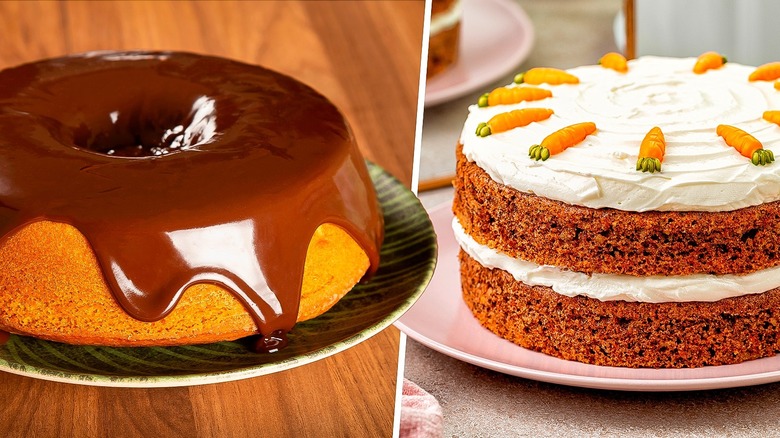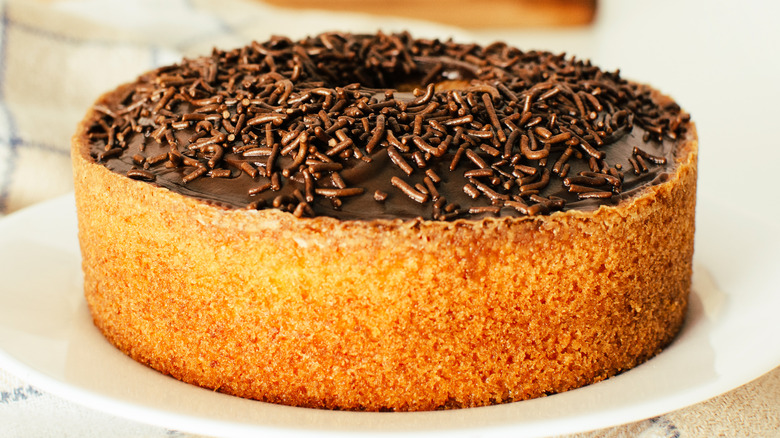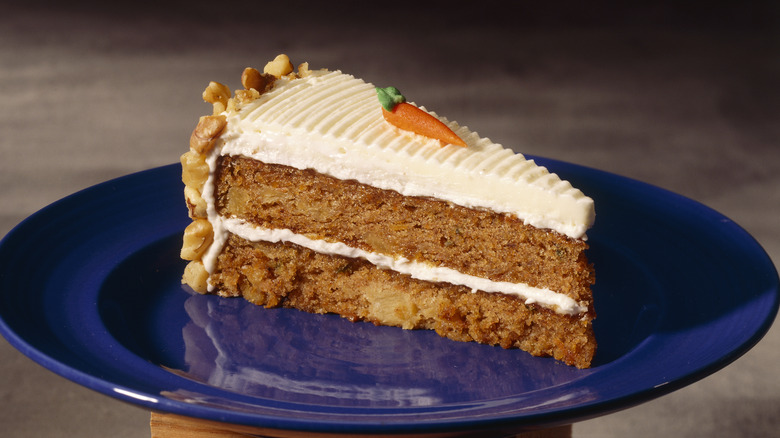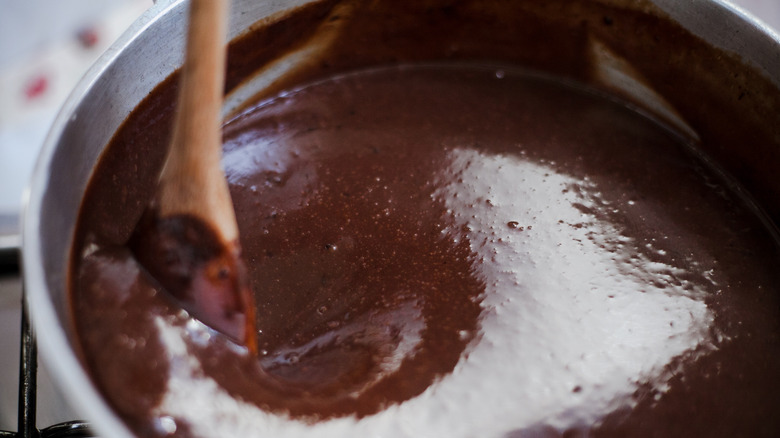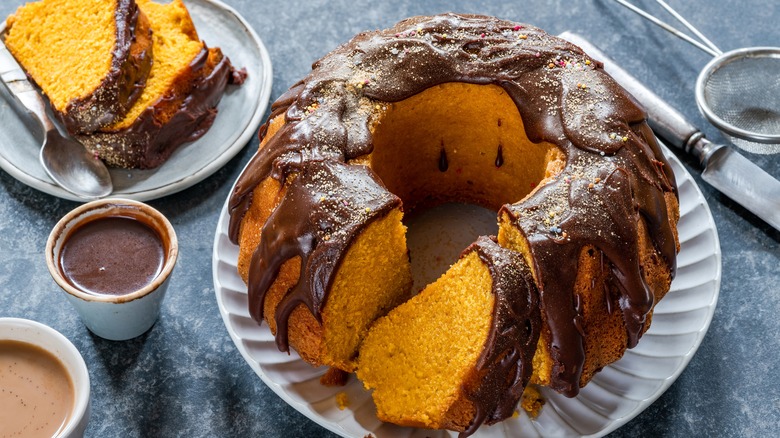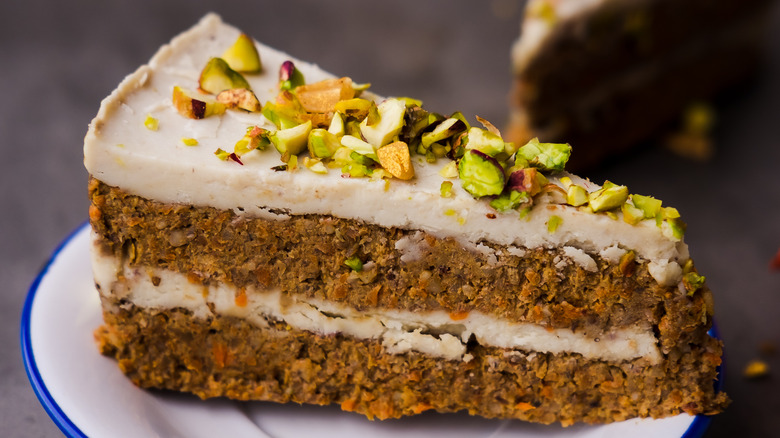The Difference Between Brazilian And American Carrot Cake
Many popular types of cake around the world integrate a wide range of fruits and vegetables. There's an undeniable allure to a strawberry sponge and even a chocolate zucchini cake comes together flavorfully. Yet there's a special magic in a carrot cake — the sweet root vegetable has everything it takes to create a moist, flavorful, and easy-to-make dish.
Americans are familiar with a two-tiered rendition, flavored with spices, filled with nuts and dried fruit, and covered in cream cheese frosting. However, the dessert also exists in Brazil, where it's called bolo de cenoura – bolo meaning cake, and cenoura meaning carrot in Portuguese.
This version takes on a critical difference: The carrots are pureed rather than grated, making the dough softer and more crumbly. Plus the cream cheese coating is swapped for chocolate glaze, altering the cake's flavor. Both versions have their individual charms, with the American cake packing in different textures in a moist base, while the Brazilian is a touch more delicate. So make room for both and add a new carrot cake to your culinary repertoire.
What is Brazilian carrot cake?
Bolo de cenoura, Brazil's take on carrot cake, is a popular dish enjoyed throughout the country. The delicious baked good has a light orange, slightly yellow interior that pleasantly crumbles when cut. The cake usually has a classic round shape, typically baked into a standard measured cake pan — around nine inches across and a couple of inches deep, although versions baked in a bundt pan are not uncommon. And it's topped with a layer of brigadeiro frosting, made from cocoa powder blended with condensed milk or sugar.
Preparing bolo de cenoura is a relatively straightforward process. The carrots, eggs, sugar, and oil are combined in a food processor or blender, saving you from grating by hand. Then the flour, baking powder, and salt are folded in. The mixture goes into a pan and bakes for around 45 minutes until a toothpick comes out clean. Such a fuss-free method, combined with the accessibility of ingredients, makes Brazilian carrot cake an everyday favorite. It's packed into lunch boxes, available at bakeries, and crafted at home as a sweet treat. And it's dependably on the table during festivities, too — making it a cake that's enjoyed on any occasion.
What is American carrot cake?
Carrot cake is one of America's most celebrated baked foods. In its most classic form, it's a fluffy two-layer creation, with cream cheese frosting separating two baked halves. The cake is spiced with warm notes of cinnamon and vanilla, and typically contains chopped pecans or walnuts, as well as raisins. The carrots are grated, which further alters the cake's texture.
The history of carrot cake goes back quite a way, with even George Washington reportedly serving a version to his guests. The cake is said to have evolved from medieval puddings, created by steaming carrots, flour, eggs, and seasonings. It became a staple of American cuisine in the 1960s, likely accelerated by a health craze for carrots.
Since then, carrot cake has expanded into many different recipes, although the creation usually follows a similar form. Baking soda, all-purpose flour, and salt are combined, while eggs are gradually added into a separate vessel with the oil and sugar. The two are melded together, into which the grated carrots and other flavorings are folded. The cake is baked for a similar duration as Brazilian carrot cake — around 45 minutes — although in two shallower pans to create the layered effect. It's then covered with cream cheese frosting to finish.
Bolo de cenoura is topped with chocolate sauce
One of the biggest differentiators between the two cakes is the frosting. American carrot cake's cream cheese frosting, made by addingeither butter, sugar, and vanilla or a mix of whipped cream and cornstarch to cream cheese, offers tanginess, sweetness, and vanilla notes, and is a fundamental flavor characteristic of the cake.
Bolo de cenoura is covered instead with chocolate frosting, lending it a different flavor palate. This icing is assembled in various ways, but most use a combination of cocoa powder, butter, and sugar, made liquid with either milk, water, or heavy cream. Sometimes, the mixture is sweetened with condensed milk, too. The result is decadent, sticky, and flavorful, making a richer carrot cake than the U.S. version.
The icing shares a name and flavor with brigadeiro, one of Brazil's most quintessential desserts. Bridadeiros are a chocolate truffle-like creation, combining condensed milk, chocolate, and butter into a soft bite. So, the chocolate icing is classically Brazilian.
Brazilian carrot cake has a super-smooth texture
Due to the way the carrots are integrated into the batter, the two cakes have different compositions. Bolo de cenoura employs a blender to merge the vegetable into the wet components of the cake until a smooth consistency is formed. The carrots are simply peeled and slightly chopped before going into the food processor. The result is a light texture which isn't dry but crumbles apart into smaller moist morsels. The cake's moisture is created by the carrot puree blending with oil added to the batter, making it a dependably tender creation.
American carrot cake similarly relies on oil to prevent dryness. However, this version grates the carrots. The vegetables soften into the batter but don't entirely dissolve, giving a slightly rougher consistency to the cake, with a less fine crumb. Often no two bites are quite identical, with some morsels being extra juicy. Additionally, American carrot cake often contains dried fruits and nuts to add textural variance, a contrast to bolo de cenoura's uniform nature. So, while this version's batter is similar, the resulting mouthfeel is different.
American carrot cake comes in more variations
Bolo de cenoura follows a classic assembly, with most bakers not straying far from the original recipe. A few small tweaks integrate more flavor — some add sour cream into the batter for an acidic note or change up the brigadeiro frosting by adding coconut cream.
Conversely, American carrot cake is flavored and filled with a broader range of components. Many ingredients elevate carrot cake, added during various stages of cooking. Deviations can start as early as the dry batter creation. Past the familiar addition of cinnamon, bakers also add nutmeg, ginger, allspice, and cloves, spinning the cake's palate. There's also room for extra flavors during wet batter assembly. The oil — which is usually flavorless — can be made more aromatic by employing a coconut fat. Some also add a pop of extra flavor by mixing in extracts, like vanilla or lemon.
The components folded in alongside the grated carrots present yet another chance for flavoring. Orangey carrot cake comes together with some citrus zest. Or, the cake can turn more tropical with a sprinkling of coconut flakes. The added fruit and nuts present yet another opportunity for creativity. Whether it's dried cranberries, fresh currants, pineapple or pistachios, carrot cake delectably merges with a broad range of flavors. However, that's not to say there's not a charm to the more minimalist Brazilian version. After all, the foundation of both cakes lies in the carrots.
